There are ghosts in our galaxy’s past. Now astronomers have found a way to detect them.
Ana Bonaca (Center for Astrophysics, Harvard & Smithsonian) announced June 11th at the meeting of the American Astronomical Society in St. Louis that she and colleagues have found evidence of a dark matter clump in the outskirts of the Milky Way. If their result, which will appear in the Astrophysical Journal (full preprint available here), pans out, it will help astronomers understand the nature of dark matter.
Dark Clumps of the Cosmos, Unite!
Most of the universe is invisible: Dark matter provides the gravitational force that holds together galaxies and clusters of galaxies, shaping large-scale cosmic structure. In fact, many cosmological simulations tracing our universe’s history focus exclusively on dark matter, which lumps together early on. These massive dark matter halos attract ordinary matter, which comes together to make stars, galaxies, and clusters.
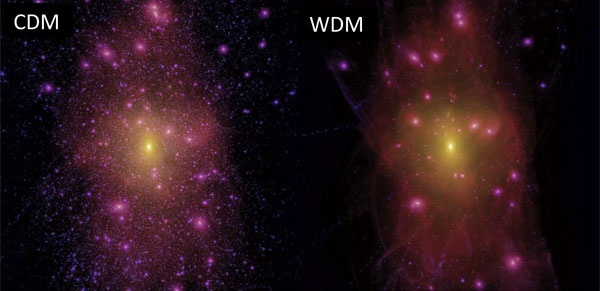
Lovell et al. / Monthly Notices of the Royal Astronomical Society 2014
But not every dark matter blob holds a galaxy. In the favored dark matter scenario, where particles are quite massive (known as cold dark matter), many smaller lumps form. Dark blobs with less than 10 million solar masses wouldn’t attract enough ordinary matter to make stars — the only way to see them is by their gravitational effects. That’s what Bonaca and colleagues set out to do when they tracked down stars belonging to a stream of stars dubbed GD-1.
The Olden-Day Globular and Its Lost Pearls
GD-1 used to be a globular cluster, one of more than 160 tightly packed spheres of stars that orbit the Milky Way. Every now and then one of these clusters comes too close to the galactic center for gravitational comfort, and the group tears apart. Starting 3 billion years ago, tidal effects began pulling stars from GD-1. Now they make a 30,000-light-year-long stellar stream, resembling a string of pearls.
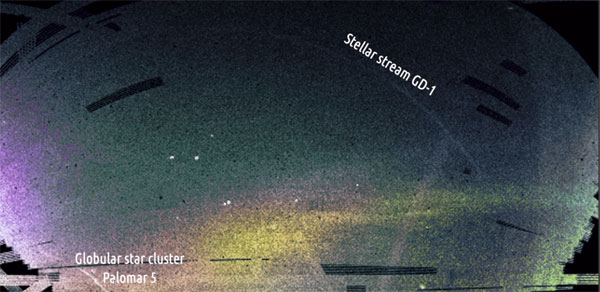
SDSS
But it turns out a few of those pearls are missing. Data from the European Space Agency’s Gaia satellite show two gaps in the seemingly continuous stream, as well as a so-called spur, whose stars orbit on orbits slightly altered from the rest of the cluster. One of the gaps probably represents the location of the globular cluster before it dissolved under gravitational forces. But the other gap and the spur associated with it require explanation.
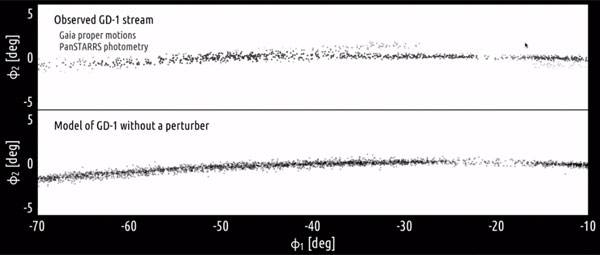
Bonaca et al. / Astrophysical Journal
Bonaca and colleagues propose that a massive object punched through GD-1 about 500 million years ago, kicking some of its stars out of their orderly orbits. According to the group’s simulations, the object would have been hefty — at least 5 million solar masses — but would have spanned between 60 and 130 light-years.
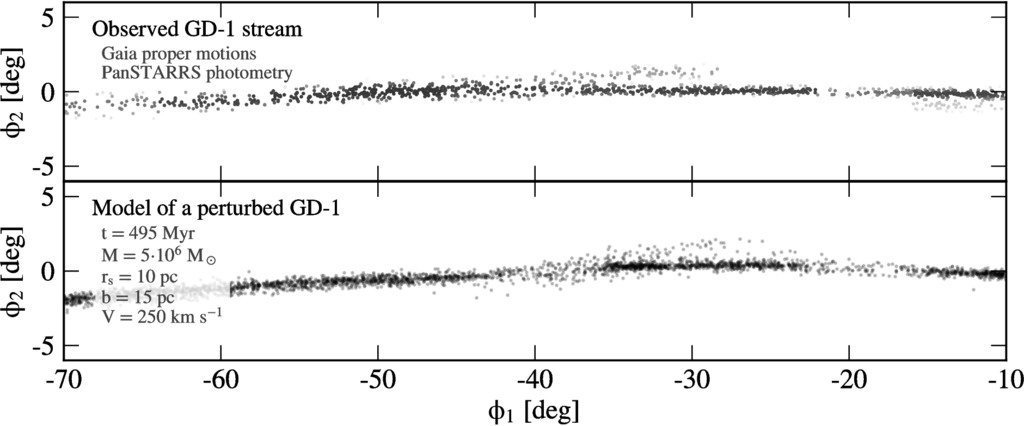
Bonaca et al. / Astrophysical Journal
“What we infer about the mass and size of this object is consistent with something like a globular cluster,” Bonaca acknowledges. “However, we have calculated the orbits of the known globular clusters, and they don’t come very close to the stream.” It's still possible, though, that a cluster currently hiding within or behind the galactic plane could be responsible for GD-1's features.
Repeating History?
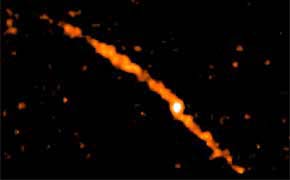
M. Odenkirchen and E. Grebel
Before GD-1, there was Palomar 5 — another torn-apart globular with obvious gaps within its stream of stars. Ultimately, Sarah Pearson (then at Columbia University) and colleagues showed that those features might have had a far simpler explanation: The bar at the center of our galaxy rotates in the same direction as Palomar 5, and can interact with its stars to slightly alter their orbits. No dark matter clumps required.
But that simple explanation doesn’t work for GD-1, which orbits in the opposite direction as the galaxy’s bar. “Because GD-1 moves in the opposite direction in our galaxy with respect to the spin of the galactic bar, and because GD1's orbit takes it quite far from the bar at its closest approach, it is less likely that the bar has had any effect on the GD-1 stream,” Pearson notes.
Bonaca and colleagues also address possible interactions with the Milky Way’s disk. GD-1 would have passed through the disk far from the galactic center, coming no closer than 40,000 light-years. The risk of running into stars or clusters out there is low, and an interaction with a large gas cloud wouldn’t have made the same kind of gap and spur.
“Whether the gap is definitely a result of a dark matter subhalo is still to be determined, but the gap and spur are indeed intriguing,” Pearson says.
Watch the simulation of a dark object crossing the GD-1 stream here:
Credit: Bonaca et al.
A Shot in the Dark
Bonaca notes that, even if a dark clump is responsible for GD-1's features, it’s difficult to draw conclusions about dark matter based on a sample of one disrupted stellar stream. But, she adds, even the existence of a single 5 million-solar-mass clump would be enough to rule out many warm dark matter models.
There’s a lot more work to be done, with GD-1 and with the other more than 40 stellar streams astronomers have discovered to date. For now, Bonaca says, “This is an exciting demonstration, a proof of principle.”
 1
1









Comments
Mike-Cavedon
June 13, 2019 at 1:08 pm
Dark matter is a supersolid that fills 'empty' space, strongly interacts with ordinary matter and is displaced by ordinary matter. What is referred to geometrically as curved spacetime physically exists in nature as the state of displacement of the supersolid dark matter. The state of displacement of the supersolid dark matter is gravity.
The supersolid dark matter displaced by a galaxy pushes back, causing the stars in the outer arms of the galaxy to orbit the galactic center at the rate in which they do.
Displaced supersolid dark matter is curved spacetime.
In the Bullet Cluster collision the dark matter has not separated from the ordinary matter. The collision is analogous to two boats that collide, the boats slow down and their bow waves continue to propagate. The water has not separated from the boats, the bow waves have. In the Bullet Cluster collision the galaxy's associated dark matter displacement waves have separated from the colliding galaxies, causing the light to lense as it passes through the waves.
What is mistaken for clumps of dark matter is displaced dark matter. The displaced dark matter causes the lensing of the light.
You must be logged in to post a comment.
You must be logged in to post a comment.